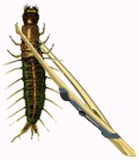
"Bug Picking"
Macroinvertebrate Field Study to assess local water quality
Description:
This field inquiry lesson will introduce students to many aquatic invertebrates and to the concept that their presence or absence can help us determine the quality of the water in streams, rivers, lakes and ponds. This activity will require students to use field equipment, take data and draw conclusions.
Background:
As our most vital natural resource, water quality and quantity is a topic of great concern to many in Texas now and will be to greater numbers of Texans in the future as they experience first-hand the effects of greater demands for water and greater impacts to water quality as human populations increase. Helping students understand aquatic ecology and water issues now insures that our voting population of the future has a sound basis from which to make decisions. As an initial exploration about water quality, this activity should lead to further investigation by educators and students about local water issues.
Objectives:
Student will:
- Use field equipment to gather and identify aquatic invertebrates.
- Take data on the number and kinds of aquatic invertebrates found.
- Draw preliminary conclusions about water quality based on the numbers and types of aquatic invertebrates found.
- Hypothesize about the effects on water quality of development in the watershed of the water body investigated.
Equipment:
Safe footwear for wading, forceps (tweezers), magnifiers, aquatic nets, pipettes, Bug Picking Data Sheet, pencils and shallow pans for holding specimens
Directions:
- Begin by discussing safety rules with students, making sure they understand the boundaries of the investigation. Always have water safety equipment available if water is more than knee deep.
- Set the stage by discussing the ability of scientists to get a picture of the water quality by looking at the animals that live in the water, with some being very sensitive to pollution and others being very tolerant of most common pollution. Refer students to the back of their student sheet that has the drawings of some of the most common invertebrates found in Texas rivers, lakes, ponds, and streams.
- Discuss also with students the roles these invertebrates play in the aquatic ecosystem, providing an important link in the aquatic food chain. At this time, and during the investigation, teachers can also point out special adaptations different organisms have to live in the water, to protect and to get food for themselves. The aquatic insects are generally the larval form of adult insects that will have wings. Refer to the Aquatic WILD activity, “Are You Me” to find the adult forms of many aquatic insects. This could be a good time to discuss metamorphosis and life cycles of insects.
- Review with students the directions on the “Bug Picking” student sheet, demonstrating how they will turn over rocks in the water or use nets to find the various invertebrates.
- Demonstrate also how they will look through debris in the nets to find the small animals and then place them in containers, categorizing them as much as possible by their different physical characteristics.
- Monitor students closely as they work to discover organisms and to divide them into categories. Help students compare the organisms they find to the ones found on the Student Data Sheet, noting on the data sheet which ones were found.
- When time for looking in the stream is up, ask students to gather in their groups to summarize what they have found and draw conclusions about the probable water quality, using the questions on the student sheet as a guide.
Did you find animals that are pollution-sensitive? (Group 1)
None
1-3 species
More than 3 species
Did you find animals that are somewhat-sensitive? (Group 2)
None
1-3 species
More than 3 species
Did you find animals that are pollution-tolerant? (Group 3)
None
1-3 species
More than 3 species
Conclusions: (Remember that the data you are taking will not give conclusive evidence of clean or polluted water, but might indicate the need for further investigation.)
- What conclusion can you draw if you found species in Group3, but not in Groups 1 or 2?
- What conclusion can you draw if you found several different species in each of the groups?
- What could be happening upstream, on land around the water upstream, or in your present location to affect the water quality where you are sampling?
This water appears to be (circle one):
Not Polluted
OK
Polluted
Resources
Furtado and Gilroy, Biomonitoring Guide, Colorado River Watch Network, January 1995.
Cummins, K. & Merrit, R. Aquatic Insects of North America, Kendall/Hunt Publishing Company, 1996.
EPA, "Rapid Bioassessemnt Protocols for Use in Streams and Rivers", May 1998.
EPA, "Volunteer Stream Monitoring: A Methods Manual", November 1997
McCafferty, Patrick W. Aquatic Entomology, Jones and Bartlett Publishers, 1983.
Save Our Streams, The Izaak Walton League of America, 1401 Wilson Blvd., Level B Arlington, Virginia 22209.
(Publishes an excellent key)
Sobel, David. Beyond Ecophobia: Reclaiming the Heart in Nature Education, 1996.
Texas Commission on Environmental Quality, WET Instruction Handbook, 2004.
Texas Parks and Wildlife, "Junior and Master Angler Education Program."
Texas Parks and Wildlife, "Clean Creek, Polluted Creek" Video produced by Texas Parks and Wildlife Department, 1994.
[top]
|

